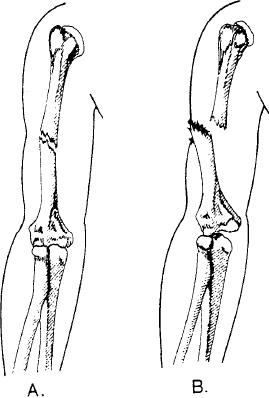
the first-aider must be covered with a saline-soaked
dressing, which must be kept wet until the victim
reaches medical personnel. When rescuing victims from
a closed space where white phosphorous is burning,
protect your lungs with a wet cloth over your nose and
mouth.
FRACTURES
Many kinds of accidents cause injuries to the bones,
joints, and muscles. In providing first aid to an injured
person, you must always look for signs of fractures
(broken bones), dislocations, sprains, strains, and
contusions (bruises).
An essential part of the first-aid treatment for
fractures consists of immobilizing the injured part with
splints so the sharp ends of broken bones do not move
around and cause further damage to the nerves, blood
vessels, or vital organs. Splints are also used to
immobilize severely injured joints or muscles and to
prevent the enlargement of extensive wounds. You must
Figure 10-48.--Types of fractures.
have a general understanding of the use of splints before
going onto learn detailed first-aid treatment for injuries
to the bones, joints, and muscles.
possible, one person should hold the splints in position
while another person fastens them.
USE OF SPLINTS
Although splints should be applied snugly, they
In an emergency almost any firm objector material
should NEVER be so tight as to interfere with the
will serve as a splint. Thus umbrellas, canes, swords,
circulation of blood. When you are applying splits to an
rifles, tent pegs, laths, sticks, oars, paddles, spars, wire,
arm or leg, try to leave the fingers or toes exposed. If the
leather, boards, pillows, heavy clothing, corrugated
tips of the fingers or toes become blue or cold, you will
cardboard, and folded newspaper may be used as splints.
know that the splints or bandages are too tight. You
A fractured leg may sometimes be splinted by fastening
should examine a splinted limb approximately every
it securely to the uninjured leg.
half hour, and loosen the fastening when the circulation
appears to be impaired. Remember that an injured limb
Splints, whether ready-made or improvised, must
is likely to swell, and splints or bandages that are applied
fulfill certain requirements. They should be lightweight,
correctly may later become too tight.
strong, fairly rigid, and long enough to reach the joints
above and below the fracture. Splints should be wide
enough so the bandages used to hold them in place do
INJURIES TO BONES
not pinch the injured part. Splints must be well padded
on the sides touching the body. If they are not properly
A break in a bone is called a FRACTURE. There are
padded, they do not fit well and will not adequately
two main types of fractures. A CLOSED FRACTURE
immobilize the injured part. When you have to
is one in which the injury is entirely internal; that is, the
improvise the padding for a splint, you may use articles
bone is broken but there is no break in the skin. An
of clothing, bandages, cotton, blankets, or other soft
OPEN FRACTURE is one in which there is an open
material. When the victim is wearing heavy clothes, you
wound in the tissues and skin. This type of break and
may be able to apply the splint on the outside, thus
wound is also referred to as a compound fracture.
allowing clothing to serve as part of the required
Sometimes the open wound is made when a sharp end
padding.
of the broken bone pushes out through the flesh;
To apply splints to an injured limb, fasten them in
sometimes it is made by an object, such as a bullet, that
penetrates from the outside. Figure 10-48 shows closed
place with bandages, strips of adhesive tape, articles of
and open fractures.
clothing, or other available material. Whenever
10-33

